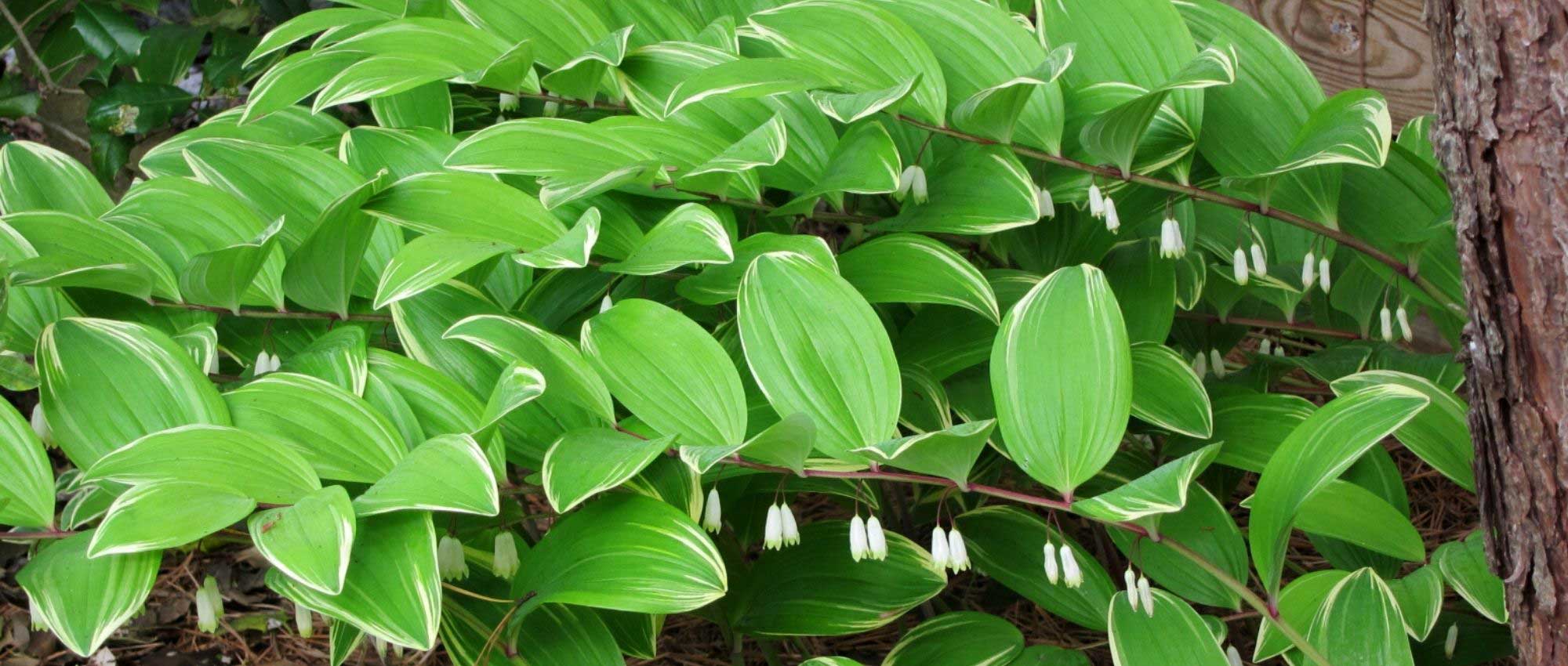
6 ideas for pairing Solomon's seal
Discover our ideas and inspiration
Contents
Solomon’s seal, or Polygonatum, is a very attractive shade perennial, which grows naturally in the understorey, and whose gracefully arching stems bear elegant green leaves, sometimes variegated. Beneath these stems, small trailing white bell-shaped flowers appear in spring. Its very delicate flowering is reminiscent of lily-of-the-valley flowers! Solomon’s seal prefers cool, loose, humus-rich soil and tolerates competition relating to roots very well. It can therefore be planted at the foot of trees and bushes. It is ideal for composing a natural-style bed, but can also be integrated into chic, contemporary gardens. Discover all our tips to pair it in the garden and create harmonious borders!
And if you want more advice on how to to grow it, feel free to consult our sheet “Solomon’s seal, Polygonatum: Planting, dividing and care”
In a woodland garden with a very natural style
Because it has a wild habit and occurs naturally in forests in France, Polygonatum is ideal for composing a shaded garden with a very natural style. Plant it in the understorey alongside ferns, such as Dryopteris for example. Also enjoy delicate flowering of Geranium nodosum, sweet woodruff, Dodecatheon jeffreyi ‘Rotlicht’ and Anemone levellei. Also discover the original Disporum cantoniense ‘Green Giant’, a very vigorous perennial that produces small creamy-white bells in spring. You can also plant lily-of-the-valley; its flowering and foliage will echo those of Polygonatum! With its small copper-orange, very delicate flowers, Epimedium ‘Amber Queen’ will also find a place alongside them.
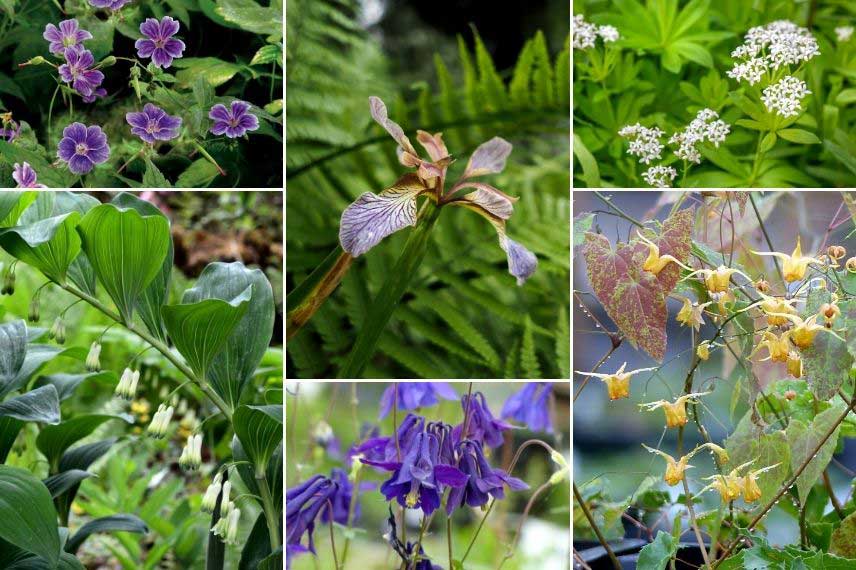
Solomon’s seal fits easily into a naturalistic understorey garden! Geranium nodosum ‘Clos du Coudray’, Iris foetidissima and Dryopteris affinis, Galium odoratum, Polygonatum multiflorum, Aquilegia vulgaris and Epimedium ‘Amber Queen’
With perennials featuring ornamental foliage
In a shady garden, you can easily highlight the foliage of Solomon’s Seal by pairing it with other perennials that offer distinctive or colourful foliage. Think, for example, of heucheras, which come in a very wide range of colours, or the variegated foliage of hostas. Ferns will, of course, have their place alongside them, whether it’s Adiantum pedatum, hart’s-tongue, Blechnum spicant, or more classic ferns such as Dryopteris. Not forgetting the small groundcover fern Onoclea sensibilis, which bears pale green, almost yellow, beautifully divided fronds. Also discover Actaea pachypoda ‘Misty Blue’, shade perennial with very finely divided, bluish leaves. You can also plant alongside them Brunnera, for their distinctive, often variegated leaves and their small blue flowers that open in spring, or the splendid Persicaria virginiana ‘Lance Corporal’, which bears green, ovate leaves marked with a dark red V-shaped blotch! Diversity of this foliage will create a lush, attractive display for much of the year, even without flowers.
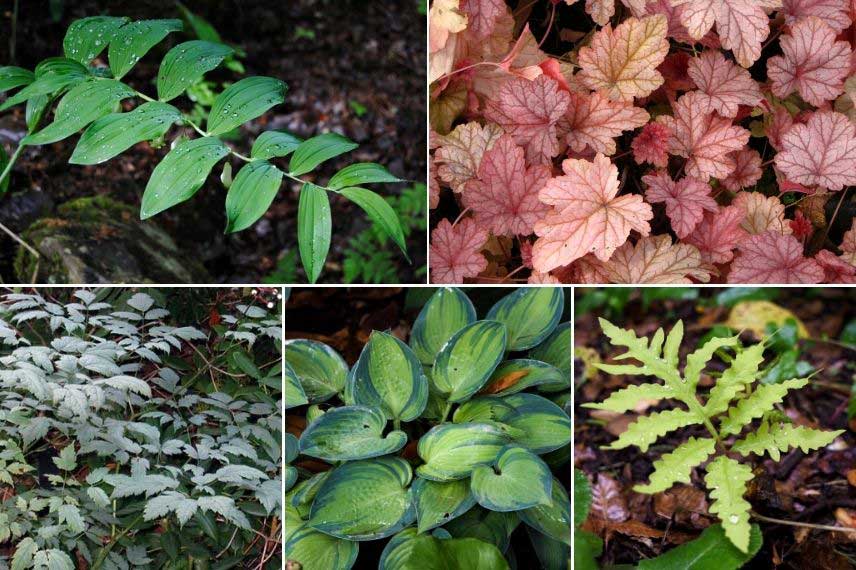
Solomon’s Seal pairs nicely with other perennials with decorative or colourful foliage. Polygonatum multiflorum, Heuchera ‘Vienna’, Actaea pachypoda ‘Misty Blue’, Hosta ‘June’ and Onoclea sensibilis
Discover other Polygonatum - Solomon's Seal
View all →Available in 1 sizes
Available in 1 sizes
Available in 2 sizes
Available in 1 sizes
Available in 1 sizes
Available in 1 sizes
In a white, elegant and light-filled garden
Enjoy variegated foliage of Solomon’s seal Polygonatum falcatum ‘Variegatum’, and pair it with white-flowering perennials or perennials with white-variegated leaves. This type of border will bring plenty of brightness to a shaded garden! The result will be elegant and pared-back, yet soft and romantic. Late white tulips, for example ‘Maureen’, and bleeding heart (Dicentra spectabilis ‘Alba’) will add a delicate touch. The airy flowers of Tiarella are also lovely. Include some bushes with variegated foliage, for example Cornus controversa ‘Variegata’. Also consider Cornus kousa ‘Chinensis’ for its white flowers.
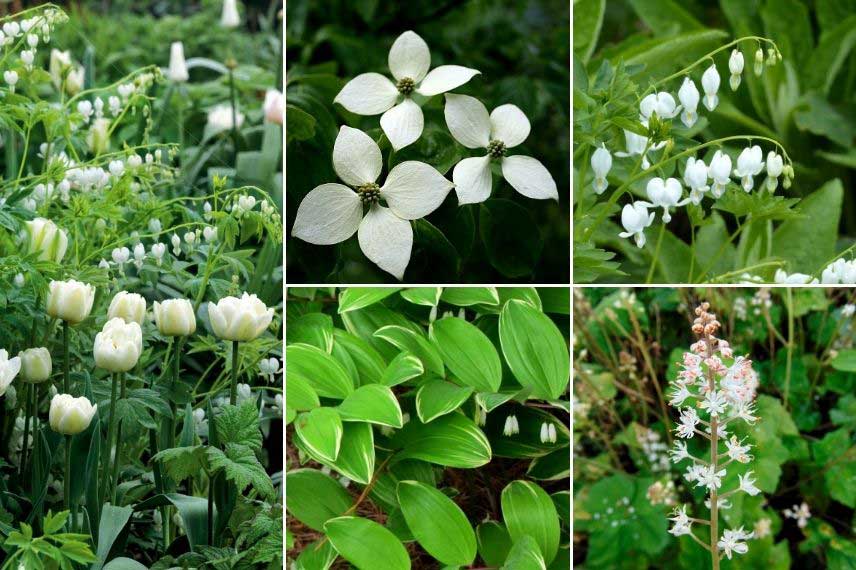
Solomon’s seal is ideal for creating a white, elegant and romantic border. Tulip ‘Spring Green’ and Dicentra spectabilis ‘Alba’ (Copyright MAP – Clive Nichols), Cornus kousa ‘Chinensis’, Dicentra spectabilis ‘Alba’ (photo PBK), Polygonatum odoratum ‘Variegatum’, Tiarella wherryi
In a contemporary, graphic-style garden
With its arching silhouette, small white flowers and ovate leaves arranged regularly along the stem, Polygonatum fits easily into a contemporary, graphic garden. You can, for example, plant it in a patio or inner courtyard, alongside ferns, such as the unusual Coniogramme emeiensis or Athyrium niponicum. Discover the striking flowering of Arisaema and their beautifully divided foliage, with an exotic style. Don’t hesitate to include some grasses: they will bring a nice contrast of shapes against larger plants or clearly defined lines and edges. For bushes, choose Mahonia ‘Soft Caress’, Nandina domestica or Fatsia japonica. Feel free to plant bamboos at the outer edge of the bed, for example Phyllostachys nigra or Fargesia ‘Black Dragon’. They will add strong graphic lines and verticality! As for Solomon’s seal, beyond common varieties, you can choose a species such as the small Polygonatum humile, which does not exceed 15 cm in height and will make a splendid groundcover.

Don’t hesitate to include Solomon’s seal in a graphic, pared-back garden! Polygonatum humile (photo Salicyna), Phyllostachys nigra, Lysimachia nummularia ‘Goldilocks’, Ophiopogon planiscapus ‘Nigrescens’ (photo brewbooks) and Arisaema concinnum
At foot of spring-flowering bushes
As Solomon’s seal tolerates root competition fairly well, you can plant it at the base of deciduous trees and bushes. It will pair wonderfully with bushes that flower in spring. Think, for example, of the elegant white flowers of Mock-oranges, the white or pink flowers of Deutzia and Weigelas, as well as Viburnum plicatum, prized for its graphic habit, with horizontal branches bearing white flowers. The delicate flowering of these bushes will beautifully complement Solomon’s seal’s small white bells. Discover also the distinctive flowering of Kalmia. To brighten the scene, take advantage of vivid shades from rhododendrons and azaleas! You can especially add plenty of brightness with the yellow flowers of Rhododendron luteum.
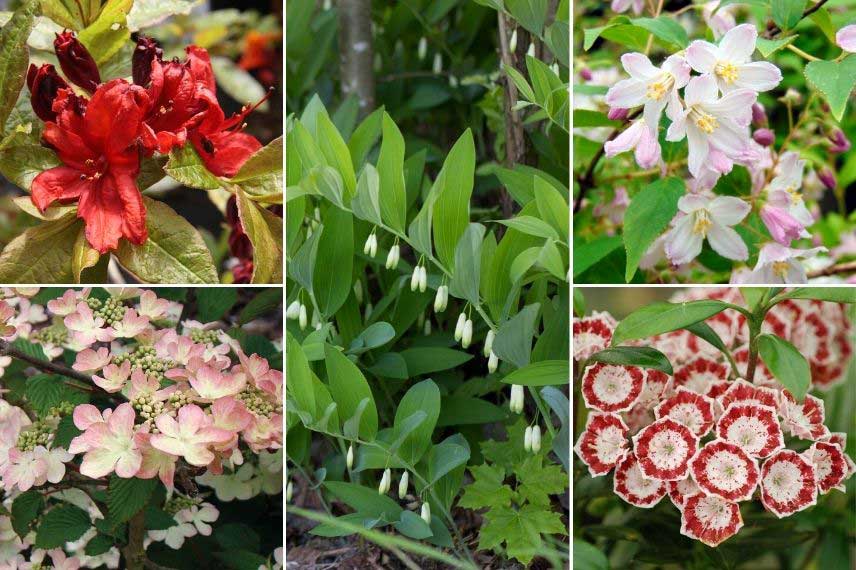
Polygonatum pairs wonderfully with bushes flowering in spring. Chinese azalea ‘Nabucco’ (photo Ben Rushbrook), Polygonatum odoratum (photo Oona Rälsänen), Deutzia purpurascens ‘Kalmiiflora’, Viburnum plicatum ‘Kilimandjaro Sunrise’ and Kalmia ‘Minuet’
With spring bulbs and perennials featuring colourful flowering
Planted alongside brightly coloured flowers, Polygonatum, with its green foliage and white bell-shaped flowers, will help showcase those bright flowering displays, while bringing lightness to the border. It provides a light, natural backdrop so those vivid flowers do not appear too heavy or oppressive. For example, you can plant Polygonatum falcatum ‘Variegatum’ alongside splendid double-flowered columbine ‘Nora Barlow’, narcissus ‘Sorbet’ and the vibrant flowers of Asian ranunculus! Also discover the intense purple-chocolate flowering of Fritillaria camschatcensis. You can also plant beside them Camassia, Lamium maculatum, Chaerophyllum hirsutum ‘Roseum’, Primula japonica, etc.
For more pairing ideas, discover our guide “10 perennial plants with late spring flowering”!
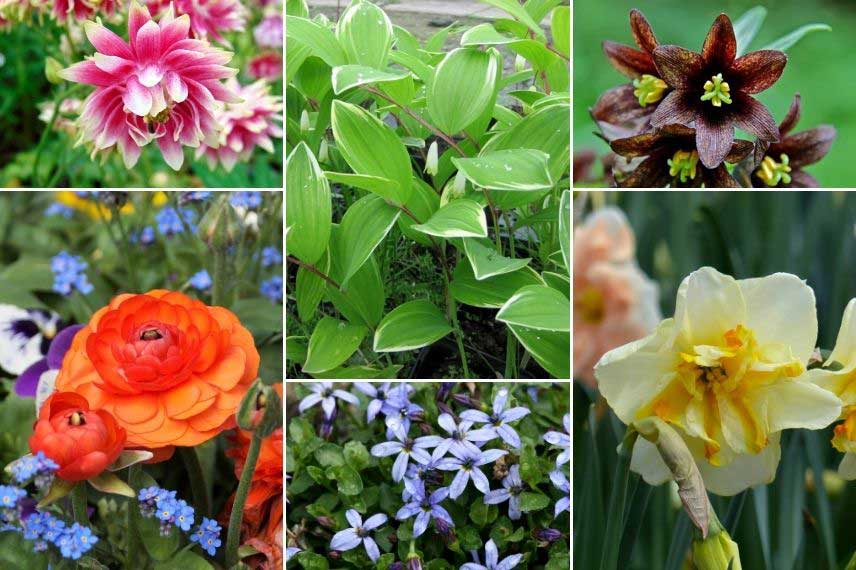
Solomon’s seal will also find its place among perennials and bulbs with colourful flowering! Aquilegia ‘Nora Barlow’, Polygonatum falcatum ‘Variegatum’, Fritillaria camschatcensis (photo Sitka National Historical Park), Asian ranunculus, Pratia pedunculata ‘County Park’ (photo V Randal Atkinson), Narcissus ‘Sorbet’
- Subscribe!
- Contents
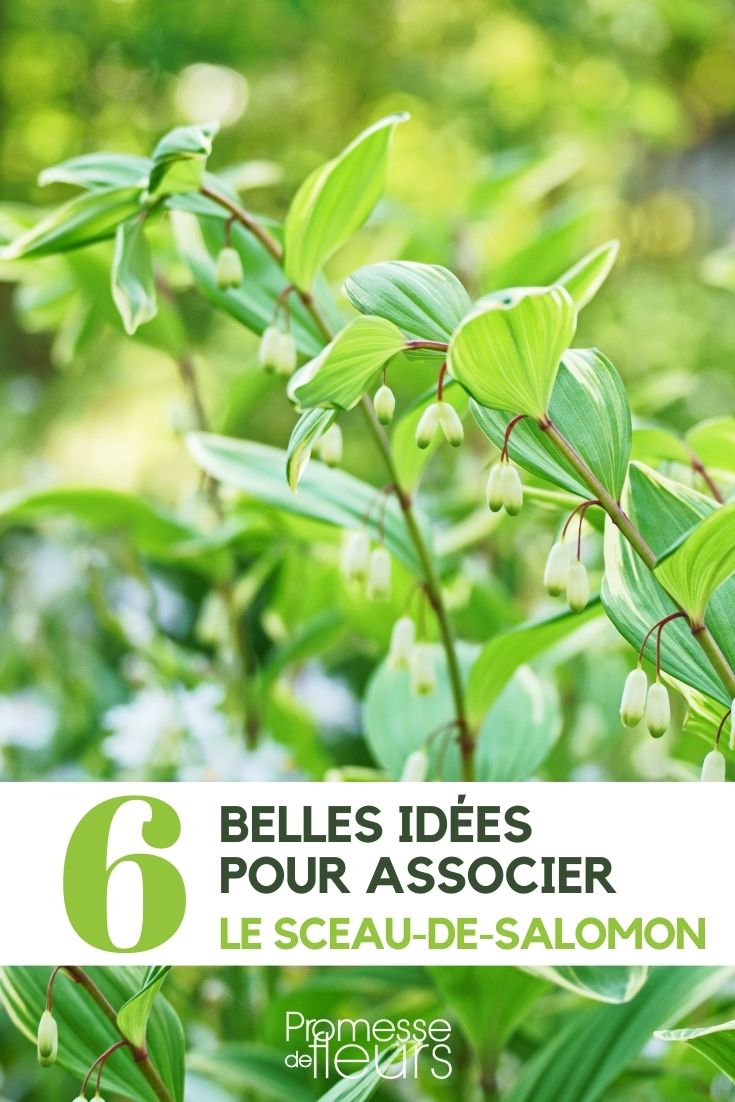































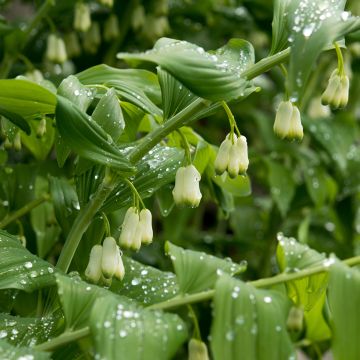

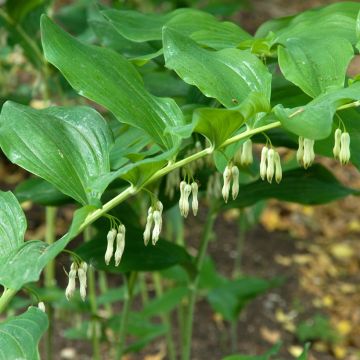
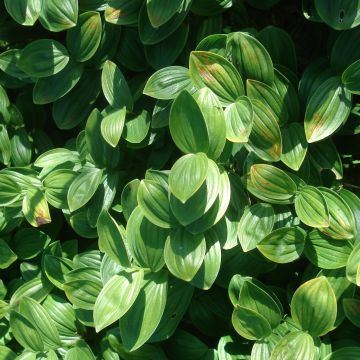
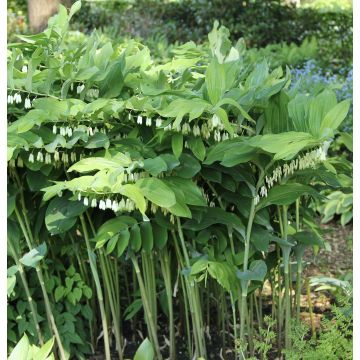
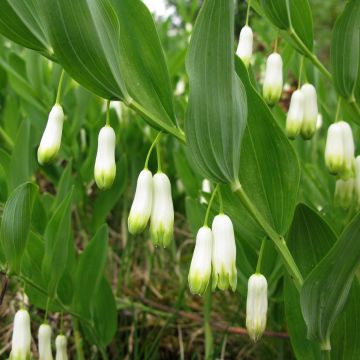
Comments